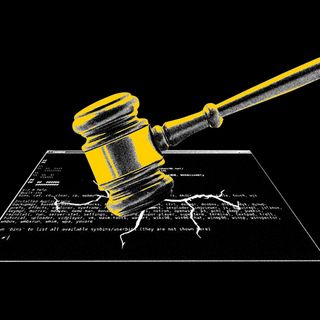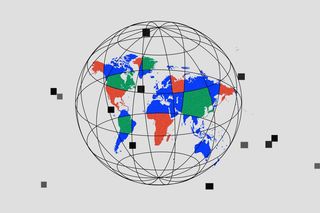
The Internet Isn’t as Borderless as It Seems. Some Have Begun to Call It the ‘Splinternet’
When the internet was still in its infancy, it was envisioned to enable a borderless utopia. Two decades on, this vision feels distant.

In 2021, Cloudfare named the Chinese-owned social media platform TikTok the most popular website on Earth, surpassing Google. Launched in 2016, the platform revolutionized the micro-video format across the internet, forcing most of its competitors to incorporate the format in their own apps. Despite its raging popularity, however, the app remains out of reach of millions of people around the world — often thanks to their own governments. Take the example of India, where the app was banned along with 58 others a few days after a border conflict with China.
India’s TikTok ban is among the prominent examples of the internet carrying geopolitical baggage. In the late 90s and early 2000s, when global internet usage was still in its infancy, the technology was envisioned to enable the coming of a new borderless utopia. In the world of the internet, everyone would be equal; walls between nations and communities would be torn apart, and geopolitical conflicts would become redundant in the digital sphere. The thinking was that the internet would herald an information revolution where anyone in any part of the globe could access all the knowledge in the world with one single click.
Two decades hence, this vision became increasingly distant. Not only has the internet failed to effect a radical shift in international politics, but instead it has become a component that reinforces existing global relations. Far from ushering in an age of global borderlessness, the internet has become entangled with global — and local — politics. In fact, instead of being rendered redundant by the internet’s influence, geopolitics has influenced the internet such that it looks different in different regions. Indeed, we are living in an age where technology commentators are increasingly using the term “splinternet” to describe the world’s powers migrating to their own, hyperlocal, internets.
Perhaps the most well-known prototype of the splinternet is in China. In 2000, in a speech he delivered at John Hopkins University, then-US President Bill Clinton noted the possibility of the internet unleashing a new information age in China. “We know how much the Internet has changed America, and we are already an open society. Imagine how much it could change China,” Clinton famously uttered. In the years that have followed, the Chinese government — in an approach known as The Great Firewall — keeps every major western website banned or censored. The country is noted to have a local alternative for every major app and website. In fact, China was already cracking down on American websites during the time of Clinton’s speech, which he also acknowledged. However, he emphasized that those attempts would go unsuccessful. “That’s sort of like trying to nail Jell-O to the wall.”
In 2022, China isn’t the only country that has tried to keep the global internet at bay. Jillian C York, an American free-expression activist, notes how location often determines what information one can access on the internet. Even something as simple as a map has different iterations depending on the region where one might want to access it. Hence, York writes, “a Pakistani user sees a sanitized version of Twitter, while an American one has access to—as far as we know—whatever content they desire.”
Related on The Swaddle:
Indian Economy Lost Rs. 20,000 Crores Due to Government’s Internet Bans in 2020
Bans, censorship, and firewalls are only some of the many ways in which countries use the internet as a tool to guide their international — and local — politics. There are other, more severe ways in which nations have at times rendered ineffective the internet’s potential of bringing in unbridled information to any person on the web. India, for instance, kept the people of the erstwhile state of Jammu and Kashmir in an extended internet shutdown for over a year following its decision to abrogate Article 370 of the Constitution. The extended ban on the internet was said to have been done to quell any protests that could occur following the government’s highly controversial move. The shutdown helped stop the passage of information from Kashmir to the outside world, and vice versa.
It is important to note here that the Kashmir situation was not the first time the Indian government decided to shut down the internet in a region. In fact, the world’s largest democracy has also been the largest enforcer of internet shutdowns for the last four years. These shutdowns have often been employed in conflict areas during protests against the government. Recently, state governments in India have also made use of shutdowns during examinations for government jobs.
Moreover, the digital space remains unevenly tilted towards the Western world. Most social media is owned and operated by companies based in America, often operating along American laws and values. York notes that this often creates grey areas when dealing with issues like terrorism. At times, American definitions determine the global legitimacy of local political actors. Hence, “in several countries, groups that the U.S. designates as terrorists are legitimate political actors, active in local or national legislatures.”
It could also create a situation where countries not aligning with larger Western interests could simply be thrown off the internet. For instance, following Russia’s invasion of Ukraine, the latter asked the Internet Corporation to Assigned Names and Numbers (ICANN), the US-based organization that manages top-level domain names, to deny Russia access to its systems. This, and other sanctions brought on Russia, have pushed it to work actively on cutting off from Western servers and systems as it tries to engineer its own sovereign internet.
At other times, social media’s ignorance of local political situations results in it not being able to efficiently curtail extremist material floating online in lower-income countries. Or, worse, social media groups may collude with these countries’ governments to be able to remain in business. For example, casteist and islamophobic hate speech and posts in India are rarely censored on these platforms. Hence, Meta or Twitter’s commitment to zero tolerance against online hate has very different definitions depending on the borders one is surrounded by.
All of this is not to say that the internet has not democratized information and knowledge to a great extent. In fact, the internet has on many occasions succeeded in bypassing information blockages enforced by governments to bring people knowledge and content through simple tools such as VPN and torrents. Internet activism has also revolved greatly around ensuring the decentralization of data by using multiple servers and tools that protect privacy. These tools and bypass mechanisms, however, remain constantly under attack by governments and businesses and are used by only a fraction of the digital population.
The larger global online population, thus, continues to be largely at the mercy of their own local internets. Or, one could say, that they remain connected to their own splinternets.
Amlan Sarkar is a staff writer at TheSwaddle. He writes about the intersection between pop culture and politics. You can reach him on Instagram @amlansarkr.
Related


What Is the Leap Second and Why Have Countries Voted to Scrap It?
